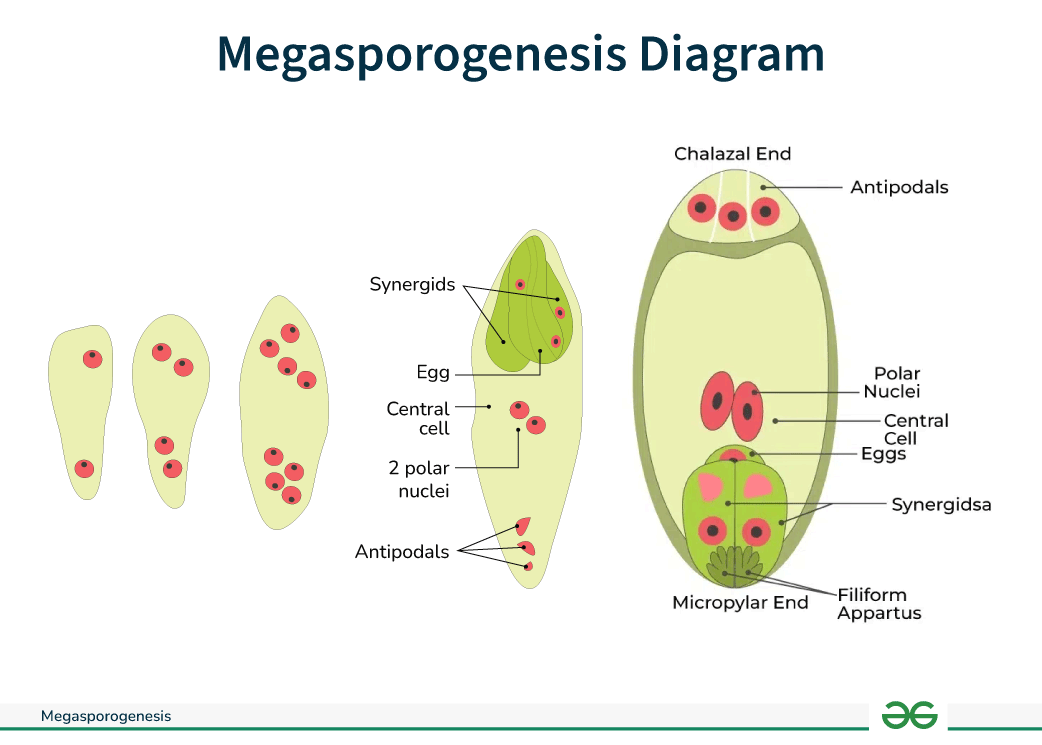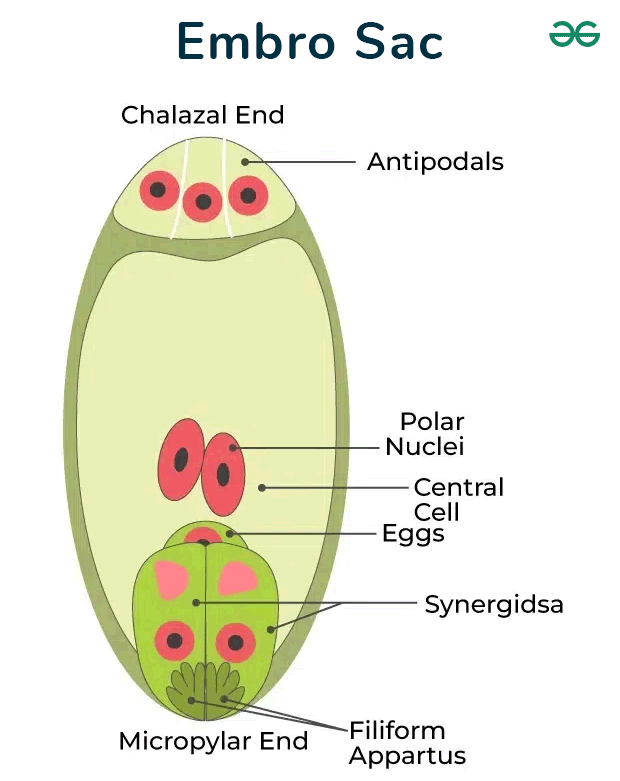Megasporogenesis – An Overview
Last Updated :
27 Mar, 2024
Megasporogenesis is a plant reproductive process leading to female gamete formation. It involves the meiotic division of a megasporocyte, producing four megaspores within an ovule. Typically, three megaspores degenerate, while the remaining one develops into a functional megaspore. In this article, find the megasporogenesis class 12 notes, the structure of Megasporangium, and more in detail.
Megasporogenesis Definition
Megasporogenesis is the meiotic process in plants that leads to the formation of megaspores, which develop into female gametophytes within ovules.
Megasporangium Meaning
Megasporangia are female sporangia that develop into megasporocytes, which in turn develop into megaspores. Sporangia are present in many different structures, such as angiosperm blooms, pteridophyte cones, and fern sori. Found within the ovules of seed plants, megasporangia undergo the process of meiosis to generate megaspores.
These megaspores then develop into female gametophytes, which contain the egg cells for fertilization. Megasporangia are important components of the plant reproductive process, facilitating the formation of female reproductive structures and ensuring the continuation of the plant life cycle.
Also Read: Sexual Reproduction in Flowering Plants
Megasporangium Structure
Structure of the Megasporangium is explained below:
- Gynoecium: Represents the female reproductive part of a flower, consisting of one or multiple carpels.
- Megasporophyll (Carpel): Comprises the stigma, style, and ovary; each carpel contains ovules.
- Ovary: Contains ovules, each housing an embryo sac, and is the site of megasporangium formation.
- Funicle: A slender stalk that elevates the developing ovule from the ovary; it facilitates nutrient and water transport.
- Hilum: The point where the ovule connects with the funicle.
- Nucellus: The multilayered body of the ovule, protected by integuments, except for the micropyle.
- Micropyle: A small pore at one end of the ovule, allowing entry for pollen during fertilization.
- Megaspore Mother Cell: Found within the nucleus of the ovule; it gives rise to the embryo sac.
- Chalaza: The opposite end of the ovule from the micropyle; it represents the ovule’s base where the funicle connects with the nucellus and integument.
Also Read: Difference Between Carpel and Pistil
Megasporangium Diagram
The labelled diagram of megasporangium is given below:

Diagram of Megasporangium
Process of Megasporogenesis
The steps involved in the process of Megasporogenesis are given below:
- Megasporogenesis (MMC) is the process of producing haploid megaspores from a diploid megaspore mother cell.
- The megaspore mother cell (MMC), a huge diploid (2n) cell, divides through meiosis to create four haploid megaspores. It also has a noticeable nucleus and dense cytoplasm.
- In most blooming plants, the other three megaspores degenerate, leaving only one viable megaspore.
- As the megaspore develops and begins to function, its nucleus undergoes mitosis and splits into eight haploid nuclei. Megasporogenesis produces a structure known as embryo-sac or megagametophyte.
- The method by which an embryo sac grows from a single megaspore is known as monosporic development. Several different types of known angiosperm embryo-sacs are categorised based on the number of megaspore nuclei involved in development.
- The two-nucleate embryo sac is formed when the two nuclei that remain after the functioning megaspore’s nucleus splits during mitosis move to opposing poles.
- Two additional successive mitotic divisions produce the four-nucleate and then eight-nucleate stages of the embryo sac.
- Following the eight-nucleated stage, cell walls start to form, resulting in the creation of a typical female gametophyte or embryo sac.
Also Read: Seed Germination-Process, Factors, Advantage
Megasporogenesis Diagram
The megasporogenesis diagram class 12 is given below:

Types of Embryo Sac Development
Different types of embryo sac are:
- Monosporic: The embryo sac develops from one viable megaspore while the other three degenerate in most angiosperms. For instance, Polygonum and Oenothera.
- Bisporic: Two of the megaspores in this kind participate in the formation of the embryo sac. Allium, scilla, and trillium are a few examples.
- Polysporic: All four megaspores in this kind participate in the formation of the embryo sac. Example: Peperomia.

The diagram of Embryo Sac
Also Read: Structure, Types & Formation of Embryo Sac
Functions of Megasporogenesis
Funnctions of Megasporogenesis are as follows:
- Megasporogenesis results in the production of megaspores, which are important for the formation of female gametophytes.
- Megaspores give rise to the female gametophyte within the ovule, providing a site for egg cell development.
- Megasporogenesis is essential for sexual reproduction in plants, ensuring the continuity of the species.
- Meiotic division during megasporogenesis contributes to genetic diversity by shuffling genetic material in the produced megaspores.
- Fertilization of the egg cell within the female gametophyte leads to seed formation, promoting the dispersal and germination of new plants.
Also Read: Asexual Reproduction in Plants
Conclusion – Megasporogenesis
Megasporogenesis is the process that leads to female gamete formation in plants. It involves the meiotic division of a megasporocyte, giving rise to four megaspores within an ovule, of which typically one develops into a functional megaspore. As the megaspore grows through megagametogenesis, its nucleus divides during mitosis to form eight haploid nuclei. An embryo-sac or megagametophyte arises from megasporogenesis. This article explores megasporogenesis, the structure of Megasporangium, and its importance in detail, providing insight into plant reproductive processes.
Also Read:
FAQs on Megasporogenesis
What is Megasporogenesis?
The process of meiotically dividing diploid megaspore mother cells to produce haploid megaspores inside the ovule of a female flowering plant is known as megasporogenesis.
What is the Difference Between Microsporogenesis and Megasporogenesis?
Microsporogenesis produces male gametophytes (pollen grains) through meiosis in the microsporangia of the anther, while megasporogenesis forms female gametophytes (embryo sacs) within the ovules of the ovary
What are the Different Types of Megaspores?
Angiosperms exhibit three patterns of megasporogenesis: monosporic, bisporic, and tetrasporic, also known as the Polygonum type, the Alisma type, and the Drusa type, respectively.
What are the Different Types of Ovules in Megasporogenesis?
Different types of ovules include monosporic, bisporic, and polysporic, depending on the number of participating megaspores in embryo sac development.
What is the Development of Megasporogenesis?
Megasporogenesis refers to the development of megaspores from the megasporocyte, the cell that undergoes meiosis.
Share your thoughts in the comments
Please Login to comment...